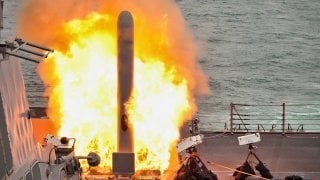The U.S. Military's Tomahawk Missile Is a Nightmare for Any Nation
Tomahawk cruise missiles enhance strategic deterrence because their long-range precision strike capability serves (or, rather, it did) as a deterrent against possible aggressors.
Officially known as BGM-109 Tomahawk, the primary cruise missile—indeed, the definitive one—of the U.S. military is a long-range, all-weather, subsonic weapon that is used primarily by the U.S. military. Originally developed by General Dynamics (now Raytheon), the Tomahawk has become emblematic of the American arsenal due to its precision, versatility, longevity, lethality, and, therefore, its enhancement of our strategic capabilities.
Yet, with the Ukraine War raging and other crises in the Middle East and Asia spreading America’s focus and resource base, leaders of Raytheon insist that they will soon expand production of the vaunted Tomahawk cruise missile by an astonishing “six-fold.”
Let’s first look back at the genesis of the Tomahawk Cruise Missile, though. It was the 1970s. Bell Bottoms and disco were all the rage. The country was still dealing with the fallout from the Vietnam War. More importantly, the Cold War between the USSR and the United States was raging. In need of an upgraded cruise missile to replace the aging Harpoon, General Dynamics created the Tomahawk.
The Tomahawk was designed to expand the U.S. Navy’s long-range capability. The missile derives its name from the Native American axe, which is meant to symbolize precision strike capability. Since it was first introduced in 1983, the Tomahawks have proven to be among America’s most ubiquitous defenses. Current variants of the Tomahawk now include enhanced GPS and integration.
A Tomahawk missile itself weighs about 3,000 pounds with a length of approximately twenty feet. Its diameter is 20.4 inches, with a wingspan of 8.6 feet. This bird travels at a sub-sonic speed of around 550 miles per hour (Mach 0.72). As for the range of these weapons, how about 1,000 nautical miles, with some models of the Tomahawk exceeding 1,500?
The Specifics
The Tomahawk utilizes a turbofan engine, which provides stealth and efficiency. The missile provides both stealth and efficiency. By using GPS, the Tomahawk ensures it can strike deep into the Earth.
Tomahawk cruise missiles enhance strategic deterrence because their long-range precision strike capability serves (or, rather, it did) as a deterrent against possible aggressors. Because these missiles can be launched from a variety of platforms, U.S. naval power is enhanced. Further, the United States can signal intent without ever actually escalating to high levels of conflict, providing a measured response.
Sadly, the Tomahawk is not the dominant system it once was. In fact, America’s enemies either have or are actively working on ways to undermine the United States.
Brandon J. Weichert, a National Interest national security analyst, is a former Congressional staffer and geopolitical analyst who is a contributor at The Washington Times, the Asia Times, and The-Pipeline. He is the author of Winning Space: How America Remains a Superpower, Biohacked: China’s Race to Control Life, and The Shadow War: Iran’s Quest for Supremacy. His next book, A Disaster of Our Own Making: How the West Lost Ukraine, is available for purchase wherever books are sold. Weichert can be followed via Twitter @WeTheBrandon.

